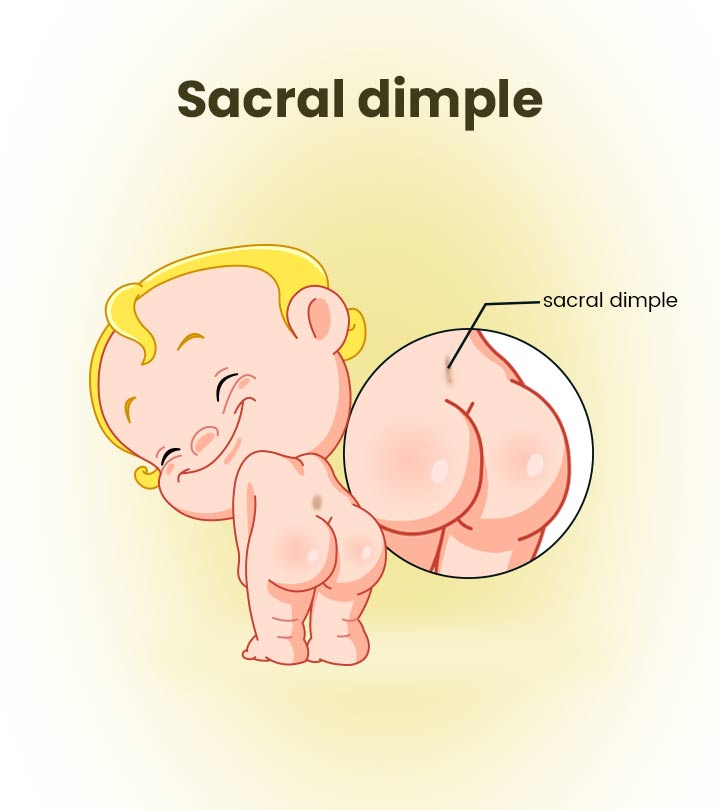Sacral dimples in newborns are characterized by shallow or deep indentations on the lower back (lower sacral region), just above the crease of the buttocks. They are a common cutaneous (relating to the skin) anomaly found during neonataliXNewborn infant under four weeks old. spinal examinations. They are also known as sacrococcygeal or coccygeal dimples or pits.
According to studies, sacral dimples are benigniXLikely not harmful. and require no medical intervention (1). They are found in 1.8–7.2% of newborns and are usually detected during routine examinations (2.). However, the exact cause of this congenital condition is unknown.
If the sacral dimples are large, located farther from the anus, or accompanied by a turf of hair, skin tag, or skin discoloration, they might be an indication of an underlying abnormality of the spinal cord. Hence, in such cases, consult your baby’s pediatrician to check if it is a cause for concern.
Read this post to learn about the reasons, types, and treatment options for sacral dimples in babies.
Types Of Sacral Dimples
Sacral dimples are of two types.
- Typical sacral dimples: These are located on the skin of the lower back, near the crease of the buttocks. Usually, you will notice no skin changes other than the shallow depression near the tailbone (coccyx) end.
- Atypical sacral dimples: In this type, the dimple is located higher up on the back or off to the side, and the bottom of the dimple may not be seen. It may also be accompanied by skin discoloration, a patch of hair, a lump, or a skin tag (3).
Consult your infant’s pediatrician if you notice an atypical dimple on your baby’s body.
Symptoms Of Abnormal Sacral Dimples
Often, sacral dimples are benign and may not be a cause for concern. However, if you find the below symptoms, it could be due to an underlying medical condition (4).
- Sacral dimples accompanied by a patch of hair, a birthmark, a deviated buttock fold, or discharge
- Abnormal scan of the neonatal spinal column
- Weakness
- Loss of sensation
- Signs of scoliosisiXAbnormal lateral curvature of the spine.
- Congenital dislocation of the hips
- Poor urine stream in boys
- PatulousiXExpanding from the center. anal opening
Possible Complications Of Sacral Dimples
Sacral dimples are associated with complications when they belong to the atypical type. These dimples usually indicate spinal cord issues. Some of the possible problems include (3) (5)
- Tethered spinal cord: In this condition, the spinal cord attaches to the tissue around the spine; thus, limiting the movement of the spinal cord within the spinal canal.
- Spina bifida: This is a mild condition wherein the spine doesn’t close around the spinal cord completely and remains within the spinal canal. Spina bifida may not cause any symptoms. Based on the data provided by the Centers for Disease Control and Prevention, the global incidence of such severe congenital disabilities among babies, including spina bifida, is around 3-6% yearly.
- Dermal sinus tract: This refers to an abnormal connection between the skin and spine. It can lead to infection.
Diagnosis Of Sacral Dimples
Sacral dimples are usually identified during the routine neonatal physical examination, and further investigations may not be required in the case of a typical sacral dimple.
However, if your doctor notices any abnormal skin changes or developmental defects near the sacrum or sacral dimple, they might recommend the following tests to rule out spinal cord problems.
Ultrasonography is considered a safe and cost-effective screening method for infants, as it is a noninvasive screening technique that does not have the risk of radiation (2).
Sometimes, your doctor may order an MRIiXA non-invasive imaging technology used for the detection, diagnosis, and monitoring of a disease.for the neonate or infant.
Treatment For Sacral Dimples
No specific treatment is needed if the sacral dimple is typical. However, the dimple or pit may collect dirt and sweat, which may increase the risk of an infection. So, try to keep the dimple area clean and avoid fecal matter from getting into it.
If your infant’s doctor diagnoses an atypical sacral dimple, they might prescribe the necessary treatment.
Sacral dimples in newborns are skin abnormalities that do not pose any threat to the baby’s health. However, be cautious if the condition presents with other symptoms, such as the symptoms of atypical sacral dimples. In such a case, delaying or ignoring treatment may lead to complications such as tethered spinal cord, spina bifida, and dermal sinus tract. Therefore, consult your child’s doctor to diagnose any skin abnormalities and seek appropriate and timely treatment. If the condition is deemed harmless, you need not worry but should maintain proper hygiene around the area.
Key Pointers
- Sacral dimples in newborns are a common skin anomaly that has different types.
- Though usually benign, sacral dimples in some cases may indicate an underlying problem.
- Hygiene is crucial to prevent infection of typical sacral dimples, whereas the atypical ones need treatment guided by the pediatrician.
A sacral dimple is a small indentation in the lower back and is usually harmless and doesn’t require treatment. Learn more in this video!












